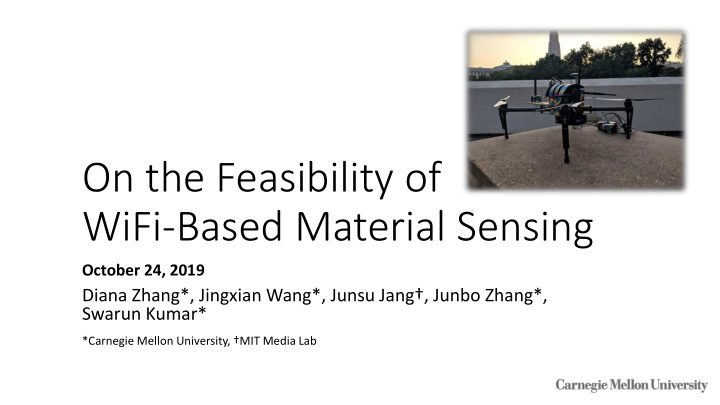



On the Feasibility of WiFi-Based Material Sensing October 24, 2019 Diana Zhang*, Jingxian Wang*, Junsu Jang†, Junbo Zhang*, Swarun Kumar* *Carnegie Mellon University, †MIT Media Lab
Drones are increasingly useful in obstacle-rich environments. Disaster Sites Warehouses Urban Settings 2
Drones must make obstacle-specific responses to maximize utility The sensing system must be infrastructure-free and contained entirely on the drone. 3
Current infrastructure-free sensing solutions cannot enable this. Obstacle Type Non-Line-of-Sight Identification Sensing ? RF-Based Vision-based (WiFi , RADAR,…) (LIDAR, Infrared,…) 4
IntuWition A complementary WiFi-Based sensing system that can detect material of obstacles in line-of-sight and non-line-of-sight settings. • Uses existing WiFi radio already on many drones • Does not assume infrastructure • Applies beyond drones – vehicles, product testing, disasters, etc. 5
IntuWition comprises two major parts: wood (1, 2) 1. Localization 1. Localization 2. Material Sensing 2. Material Sensing metal (3, 6) human (9, 2) Tx Rx 6
Radar Polarimetry can measure material-specific responses α wood =180° Different α values can be used to distinguish materials α metal =90° 7
To bring Radar Polarimetry to WiFi, a vertically polarized signal must be transmitted and received α wood =180° α metal =90° 8
Challenge #1: Multi-Bounce Vs. 9
Since the α values of multi-bounce are related to the single-reflection, these can be removed α wood =180° α metal =90° Algorithm looks for alpha and locations that are consistent with physics of multi- bounce, to eliminate them as spurious (details in paper) 10
Challenge #2: Several Variations in Material 11
Solution: Devise machine learning models Material Classification Accuracy by Model 100 94 88 90 76 80 73 69 70 Accuracy (%) 60 50 40 30 20 10 0 PCA kNN SVM NB MLP Machine Learning Model ML model accounts for additional challenges: location, texture – details in the paper. 12
IntuWition’s System Overview: IN SUMMARY… 13
We tested polarimetry as a material identification feature across a variety of materials and platforms. 14
Our system showed high classification rates for five classes of materials. 5 classes, sheets of material 15
Further, our system also worked well for classifying real-life objects as wood or metal. Wood vs. Metal Classification of Real-Life Objects 16
Limitations • Can’t detect signal when too weak, too occluded, or too many multi -bounce effects • Cannot distinguish materials of similar polarization characteristics • May respond excessively to surface characteristics (e.g. clothing) 17
IntuWition is a system that explores sensing the material and location of occluded objects • Uses COTS WiFi radios • Our evaluation demonstrates promising accuracy in material classification • Applies broadly beyond drones: vehicles, disaster response, product testing, etc. • Future work includes more objects, on-board processing, and sensor fusion www.witechlab.com/intuwition 18
Recommend
More recommend